Uncovering the Differences: How DLQI and WHO-5 Scores Vary in Moderate-to-Severe Psoriasis Patients Treated with Tildrakizumab 100 mg vs. 200 mg?
Abstract
1. Introduction
2. Materials and Methods
3. Results
4. Discussion
5. Conclusions
Author Contributions
Funding
Institutional Review Board Statement
Informed Consent Statement
Data Availability Statement
Conflicts of Interest
References
- Bu, J.; Ding, R.; Zhou, L.; Chen, X.; Shen, E. Epidemiology of Psoriasis and Comorbid Diseases: A Narrative Review. Front. Immunol. 2022, 13, 880201. [Google Scholar] [CrossRef] [PubMed]
- Trovato, E.; Rubegni, P.; Cinotti, E. The Immunogenetics of Psoriasis. Adv. Exp. Med. Biol. 2022, 1367, 105–117. [Google Scholar] [PubMed]
- Armstrong, A.W.; Read, C. Pathophysiology, Clinical Presentation, and Treatment of Psoriasis: A Review. JAMA 2020, 323, 1945–1960. [Google Scholar] [CrossRef] [PubMed]
- Trovato, E.; Cartocci, A.; Calabrese, L.; D’onghia, M.; Dragotto, M.; Capalbo, E.; Silvi, G.; Margiotta, F.M.; Pimpinelli, N.; Pellegrino, M.; et al. Pso-Reg: A web registry for psoriasis in real life. Ital. J. Dermatol. Venereol. 2023, 158, 249–254. [Google Scholar] [CrossRef] [PubMed]
- Estoque, R.C.; Togawa, T.; Ooba, M.; Gomi, K.; Nakamura, S.; Hijioka, Y.; Kameyama, Y. A review of quality of life (QOL) assessments and indicators: Towards a “QOL-Climate” assessment framework. AMBIO 2019, 48, 619–638. [Google Scholar] [CrossRef]
- Ryff, C.D. Psychological Well-Being Revisited: Advances in the Science and Practice of Eudaimonia. Psychother. Psychosom. 2014, 83, 10–28. [Google Scholar] [CrossRef]
- Blackstone, B.; Patel, R.; Bewley, A. Assessing and Improving Psychological Well-Being in Psoriasis: Considerations for the Clinician. Psoriasis Targets Ther. 2022, 12, 25–33. [Google Scholar] [CrossRef]
- Guerra-Farfan, E.; Garcia-Sanchez, Y.; Jornet-Gibert, M.; Nuñez, J.H.; Balaguer-Castro, M.; Madden, K. Clinical practice guidelines: The good, the bad, and the ugly. Injury 2023, 54 (Suppl. S3), S26–S29. [Google Scholar] [CrossRef]
- Armstrong, A.W.; Bohannan, B.; Mburu, S.; Coates, L.C.; Ogdie, A.; Alarcon, I.; Kasparek, T.; Frade, S.; Barrio, S.F.; Augustin, M. Patient Perspectives on Psoriatic Disease Burden: Results from the Global Psoriasis and Beyond Survey. Dermatology 2023, 239, 621–634. [Google Scholar] [CrossRef]
- Mattei, P.; Corey, K.; Kimball, A. Psoriasis Area Severity Index (PASI) and the Dermatology Life Quality Index (DLQI): The correlation between disease severity and psychological burden in patients treated with biological therapies. J. Eur. Acad. Dermatol. Venereol. 2014, 28, 333–337. [Google Scholar] [CrossRef]
- Aydin, S.Z.; Kimyon, G.; Ozisler, C.; Tarhan, E.F.; Gunal, E.K.; Kucuk, A.; Omma, A.; Solmaz, D.; Ersozlu, E.D.; Yildiz, F.; et al. Psoriasis Symptom Inventory (PSI) as a patient-reported outcome in mild psoriasis: Real life data from a large psoriatic arthritis registry. Eur. J. Rheumatol. 2020, 7, 64–67. [Google Scholar] [CrossRef] [PubMed]
- Topp, C.W.; Østergaard, S.D.; Søndergaard, S.; Bech, P. The WHO-5 Well-Being Index: A systematic review of the literature. Psychother. Psychosom. 2015, 84, 167–176. [Google Scholar] [CrossRef]
- Koren, J.; Lambert, J.L.; Thomsen, S.F.; McAteer, H.; Fabbrocini, G.; Corazza, V.; Jullien, D.; Augustin, M.; Warren, R.B.; de Rie, M.A.; et al. Elevating the Standard of Care for Patients with Psoriasis: ‘Calls to Action’ from Epicensus, a Multistakeholder Pan-European Initiative. Dermatol. Ther. 2023, 13, 245–268. [Google Scholar] [CrossRef]
- Galluzzo, M.; Chiricozzi, A.; Cinotti, E.; Brunasso, G.; Congedo, M.; Esposito, M.; Franchi, C.; Malara, G.; Narcisi, A.; Piaserico, S.; et al. Tildrakizumab for treatment of moderate to severe psoriasis: An expert opinion of efficacy, safety, and use in special populations. Expert. Opin. Biol. Ther. 2022, 22, 367–376. [Google Scholar] [CrossRef]
- Reich, K.; Papp, K.A.; Blauvelt, A.; Tyring, S.K.; Sinclair, R.; Thaçi, D.; Nograles, K.; Mehta, A.; Cichanowitz, N.; Li, Q.; et al. Tildrakizumab versus placebo or etanercept for chronic plaque psoriasis (reSUR-FACE 1 and reSURFACE 2): Results from two randomised controlled, phase 3 trials. Lancet 2017, 390, 276–288. [Google Scholar] [CrossRef]
- Gargiulo, L.; Ibba, L.; Ingurgio, R.C.; Malagoli, P.; Amoruso, F.; Balato, A.; Bardazzi, F.; Brianti, P.; Brunasso, G.; Burlando, M.; et al. Comparative effectiveness of tildrakizumab 200 mg versus tildrakizumab 100 mg in psoriatic patients with high disease burden or above 90 kg of body weight: A 16-week multicenter retrospective study—IL PSO (Italian landscape psoriasis). J. Dermatol. Treat. 2024, 35, 2350760. [Google Scholar] [CrossRef] [PubMed]
- Caldarola, G.; Galluzzo, M.; Bernardini, N.; Calabrese, L.; Grimaldi, M.; Moretta, G.; Pagnanelli, G.; Shumak, R.G.; Talamonti, M.; Tofani, L.; et al. Tildrakizumab in moderate-to-severe plaque psoriasis: A multicenter, retrospective, real-life study. Dermatol. Ther. 2022, 35, e15488. [Google Scholar] [CrossRef]
- De Simone, C.; Force, S.P.W.; Calabrese, L.; Balato, A.; Cannavò, S.P.; Dattola, A.; Esposito, M.; Fargnoli, M.C.; Giuffrida, R.; Hansel, K.; et al. Psoriasis and its management in women of childbearing age: Tools to increase awareness in dermatologists and patients. Ital. J. Dermatol. Venereol. 2020, 155, 434–440. [Google Scholar] [CrossRef]
- Zhang, H.; Yang, Z.; Tang, K.; Sun, Q.; Jin, H. Stigmatization in Patients with Psoriasis: A Mini Review. Front. Immunol. 2021, 12, 715839. [Google Scholar] [CrossRef] [PubMed]
- Jankowiak, B.; Krajewska-Kułak, E.; Jakoniuk, M.; Khvorik, D.F. Stigmatization among Patients with Plaque Psoriasis. J. Clin. Med. 2023, 12, 6425. [Google Scholar] [CrossRef]
- Liu, L.; Daum, C.; Miguel Cruz, A.; Neubauer, N.; Perez, H.; Rincón, A.R. Ageing, technology, and health: Advancing the concepts of autonomy and in-dependence. Health Manag. Forum 2022, 35, 296–300. [Google Scholar] [CrossRef] [PubMed]
- Janowski, K.; Steuden, S.; Pietrzak, A.; Krasowska, D.; Kaczmarek, D.; Gradus, I.; Chodorowska, G. Social support and adaptation to the disease in men and women with psoriasis. Arch. Dermatol. Res. 2012, 304, 421. [Google Scholar] [CrossRef]
- Vahedi, S. World Health Organization Quality-of-Life Scale (WHOQOL-BREF): Analyses of Their Item Response Theory Properties Based on the Graded Responses Model. Iran. J. Psychiatry 2010, 5, 140–153. [Google Scholar] [PubMed]
- Ware, J.E., Jr.; Sherbourne, C.D. The MOS 36-item short-form health survey (SF-36). I. Conceptual framework and item selection. Med. Care 1992, 30, 473–483. [Google Scholar] [CrossRef]
- Otuki, M.; Reis, R.; Cabrini, D.; Prudente, A.; Horinouchi, C.; Correr, C. Patient-reported outcomes in psoriasis research and practice. Br. J. Dermatol. 2011, 165, 1361–1362. [Google Scholar] [CrossRef]
- Calabrese, L.; Malvaso, D.; Antonelli, F.; Mannino, M.; Peris, K.; Chiricozzi, A. Investigational systemic drugs for moderate to severe plaque psoriasis: What’s new? Expert Opin. Investig. Drugs 2023, 32, 229–243. [Google Scholar] [CrossRef] [PubMed]
- Finlay, A.; Khan, G. Dermatology Life Quality Index(DLQI)—A simple practical measure for routine clinical use. Clin. Exp. Dermatol. 1994, 19, 210–216. [Google Scholar] [CrossRef] [PubMed]
- Maul, J.-T.; Maul, L.W.; Didaskalu, J.A.; Valenzuela, F.; Romiti, R.; Peterson, H.; Korouri, E.; Novoa, F.; Oon, H.H.; Zheng, M.; et al. Correlation between Dermatology Life Quality Index and Psoriasis Area and Severity Index in Patients with Psoriasis: A Cross-sectional Global Healthcare Study on Psoriasis. Acta Derm.-Venereol. 2024, 104, adv20329. [Google Scholar] [CrossRef]
- Omani-Samani, R.; Maroufizadeh, S.; Almasi-Hashiani, A.; Sepidarkish, M.; Amini, P. The WHO-5 Well-Being Index: A Validation Study in People with Infertility. Iran. J. Public. Health 2019, 48, 2058–2064. [Google Scholar] [CrossRef]
- Campione, E.; Lambiase, S.; Shumak, R.G.; Galluzzo, M.; Lanna, C.; Costanza, G.; Borselli, C.; Artosi, F.; Cosio, T.; Tofani, L.; et al. A Real-Life Study on the Use of Tildrakizumab in Psoriatic Patients. Pharmaceuticals 2023, 16, 526. [Google Scholar] [CrossRef]
- Fredriksson, T.; Pettersson, U. Severe psoriasis--oral therapy with a new retinoid. Dermatologica 1978, 157, 238–244. [Google Scholar] [CrossRef] [PubMed]
- Blauvelt, A.; Sofen, H.; Papp, K.; Gooderham, M.; Tyring, S.; Zhao, Y.; Lowry, S.; Mendelsohn, A.; Parno, J.; Reich, K. Tildrakizumab efficacy and impact on quality of life up to 52 weeks in patients with moderate-to-severe psoriasis: A pooled analysis of two randomized controlled trials. J. Eur. Acad. Dermatol. Venereol. 2019, 33, 2305–2312. [Google Scholar] [CrossRef] [PubMed]
- Kimball, A.; Papp, K.; Reich, K.; Gooderham, M.; Li, Q.; Cichanowitz, N.; La Rosa, C.; Blauvelt, A. Efficacy and safety of tildrakizumab for plaque psoriasis with continuous dosing, treatment interruption, dose adjustments and switching from etanercept: Results from phase III studies. Br. J. Dermatol. 2020, 182, 1359–1368. [Google Scholar] [CrossRef] [PubMed]
- Papp, K.; Thaçi, D.; Reich, K.; Riedl, E.; Langley, R.; Krueger, J.; Gottlieb, A.; Nakagawa, H.; Bowman, E.; Mehta, A.; et al. Tildrakizumab (MK-3222), an anti-interleukin-23p19 monoclonal antibody, improves psoriasis in a phase IIb randomized placebo-controlled trial. Br. J. Dermatol. 2015, 173, 930–939. [Google Scholar] [CrossRef]
- Chernyshov, P.V. The Evolution of Quality of Life Assessment and Use in Dermatology. Dermatology 2019, 235, 167–174. [Google Scholar] [CrossRef]
- Ghazawi, F.M.; Mahmood, F.; Kircik, L.; Poulin, Y.; Bourcier, M.; Vender, R.; Wiseman, M.C.; Lynde, C.; Litvinov, I.V. A Review of the Efficacy and Safety for Biologic Agents Targeting IL-23 in Treating Psoriasis with the Focus on Tildrakizumab. Front. Med. 2021, 8, 702776. [Google Scholar] [CrossRef]
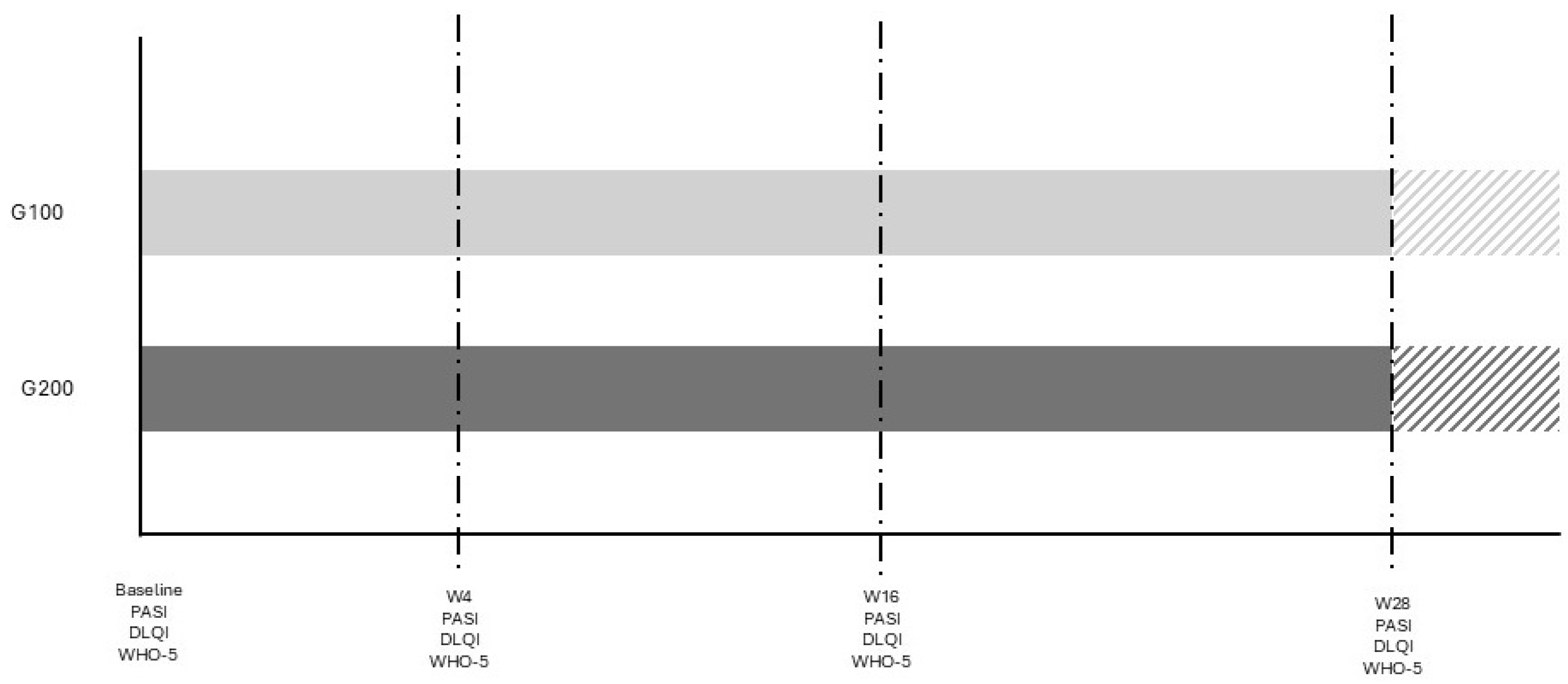
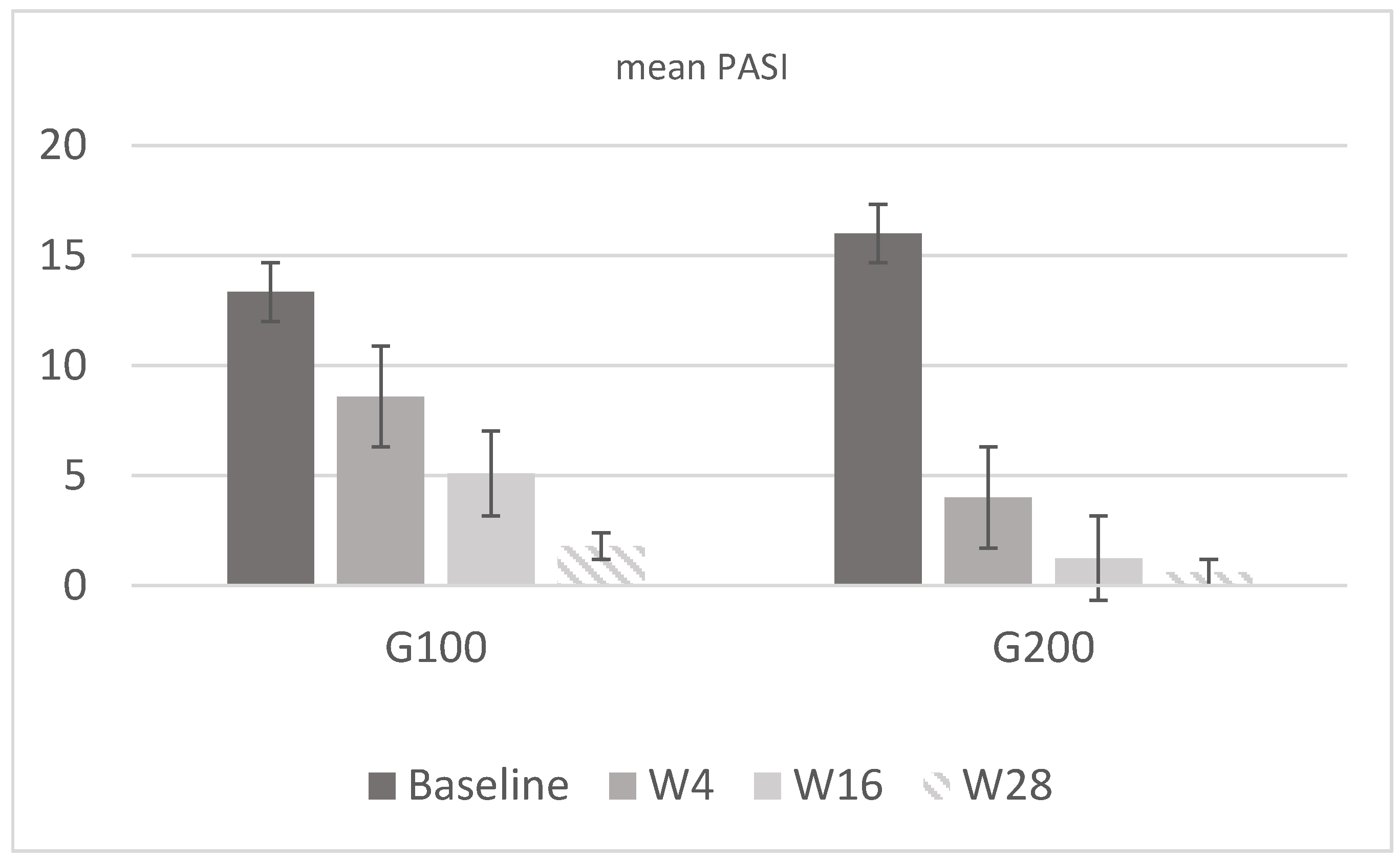
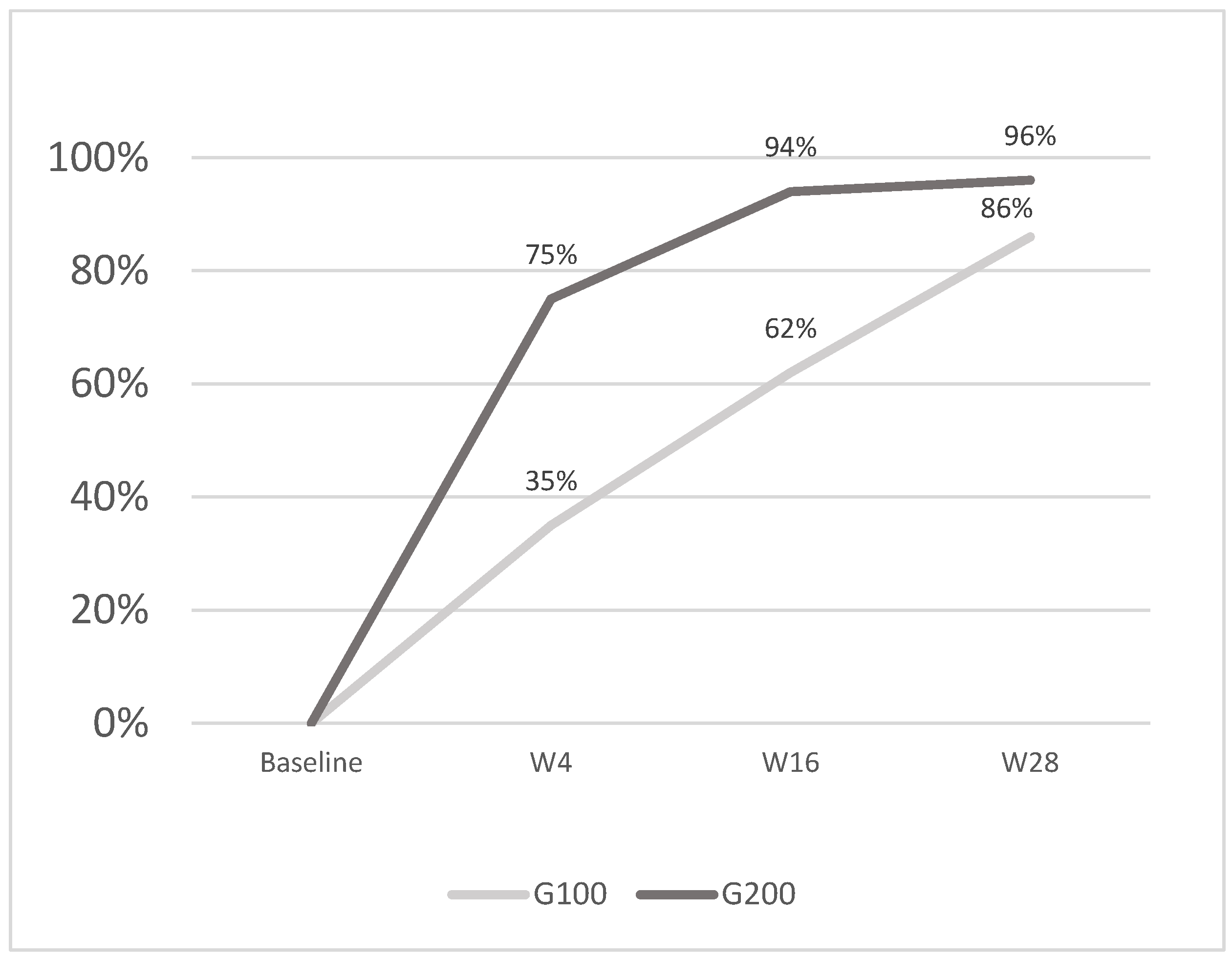
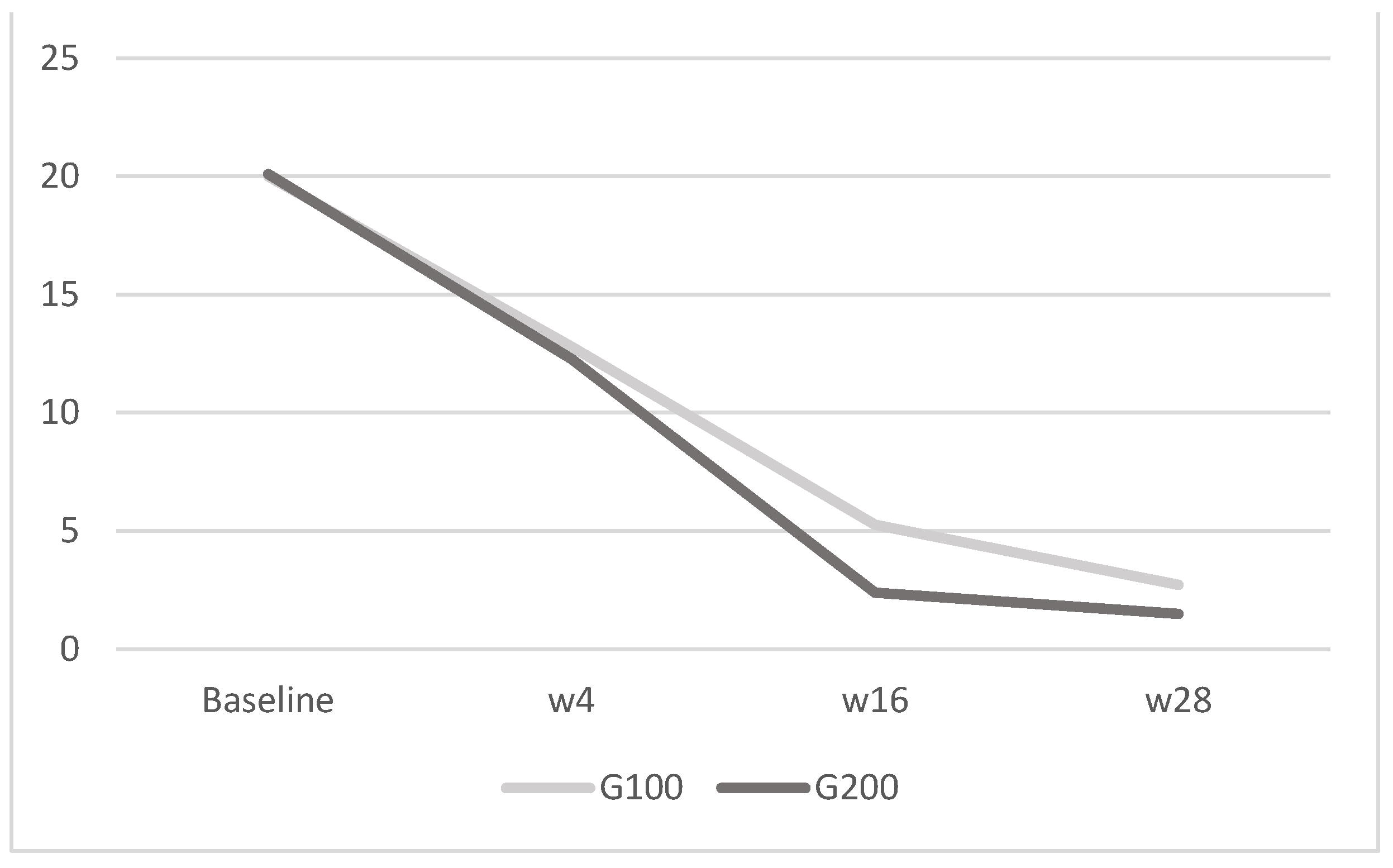
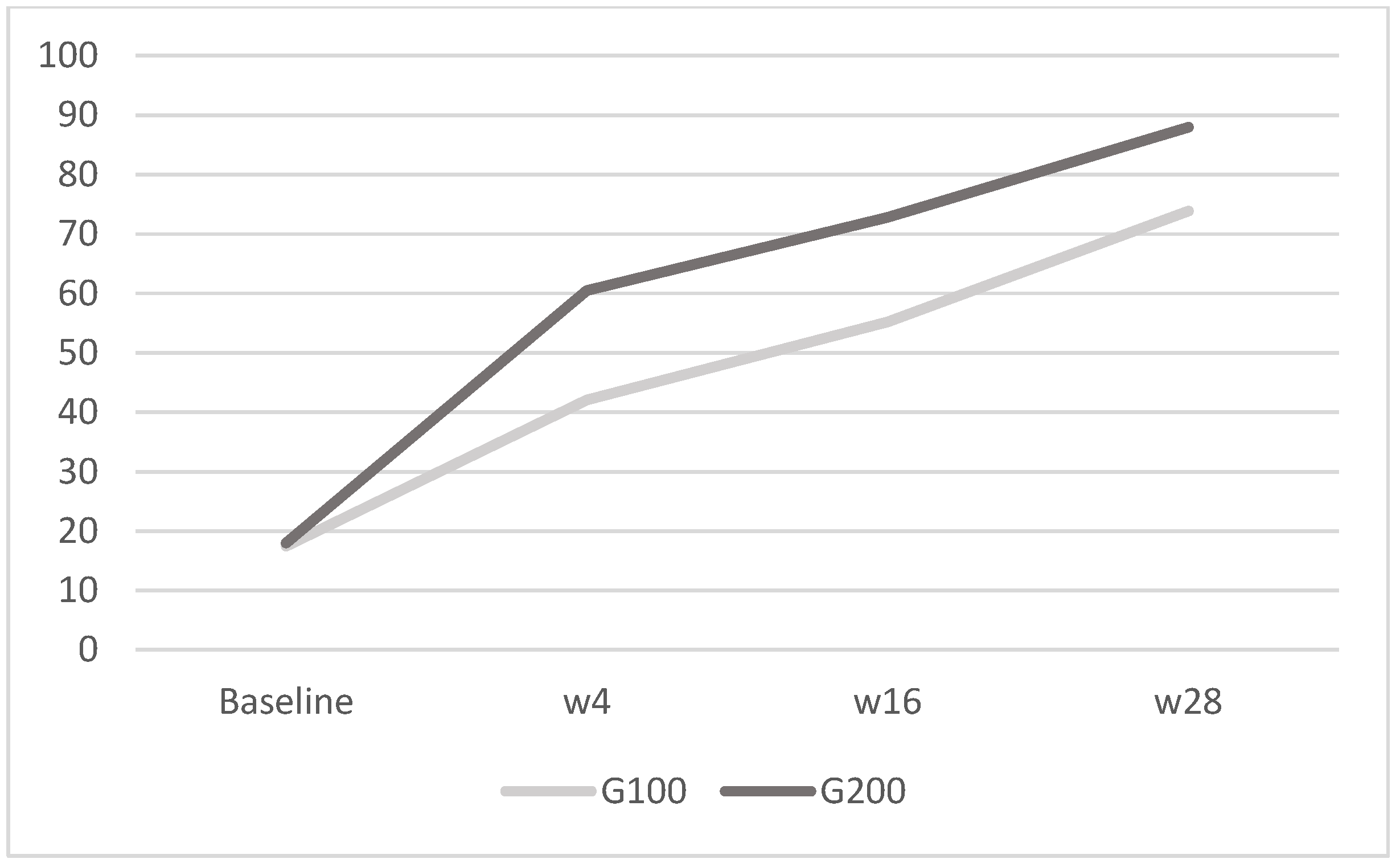
Disclaimer/Publisher’s Note: The statements, opinions and data contained in all publications are solely those of the individual author(s) and contributor(s) and not of MDPI and/or the editor(s). MDPI and/or the editor(s) disclaim responsibility for any injury to people or property resulting from any ideas, methods, instructions or products referred to in the content. |
© 2024 by the authors. Licensee MDPI, Basel, Switzerland. This article is an open access article distributed under the terms and conditions of the Creative Commons Attribution (CC BY) license (https://creativecommons.org/licenses/by/4.0/).
Share and Cite
Trovato, E.; Dragotto, M.; Capalbo, E.; Cartocci, A.; Rubegni, P.; Calabrese, L. Uncovering the Differences: How DLQI and WHO-5 Scores Vary in Moderate-to-Severe Psoriasis Patients Treated with Tildrakizumab 100 mg vs. 200 mg? J. Clin. Med. 2024, 13, 5240. https://doi.org/10.3390/jcm13175240
Trovato E, Dragotto M, Capalbo E, Cartocci A, Rubegni P, Calabrese L. Uncovering the Differences: How DLQI and WHO-5 Scores Vary in Moderate-to-Severe Psoriasis Patients Treated with Tildrakizumab 100 mg vs. 200 mg? Journal of Clinical Medicine. 2024; 13(17):5240. https://doi.org/10.3390/jcm13175240
Chicago/Turabian StyleTrovato, Emanuele, Martina Dragotto, Eugenio Capalbo, Alessandra Cartocci, Pietro Rubegni, and Laura Calabrese. 2024. "Uncovering the Differences: How DLQI and WHO-5 Scores Vary in Moderate-to-Severe Psoriasis Patients Treated with Tildrakizumab 100 mg vs. 200 mg?" Journal of Clinical Medicine 13, no. 17: 5240. https://doi.org/10.3390/jcm13175240
APA StyleTrovato, E., Dragotto, M., Capalbo, E., Cartocci, A., Rubegni, P., & Calabrese, L. (2024). Uncovering the Differences: How DLQI and WHO-5 Scores Vary in Moderate-to-Severe Psoriasis Patients Treated with Tildrakizumab 100 mg vs. 200 mg? Journal of Clinical Medicine, 13(17), 5240. https://doi.org/10.3390/jcm13175240





